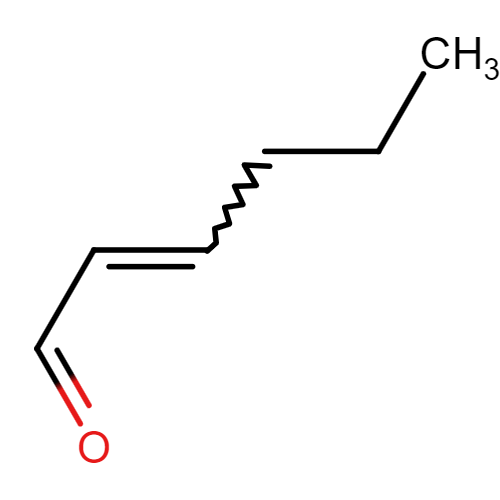2-Hexenal
| Compound Structure: |

|
||||||||||||||||||||||||||||||||||||||||||||||||
|---|---|---|---|---|---|---|---|---|---|---|---|---|---|---|---|---|---|---|---|---|---|---|---|---|---|---|---|---|---|---|---|---|---|---|---|---|---|---|---|---|---|---|---|---|---|---|---|---|---|
| Synonyms: | trans-2-Hexenal;6728-26-3;2-HEXENAL;Hex-2-enal;Leaf aldehyde;(E)-Hex-2-enal;505-57-7;(E)-2-HEXENAL;trans-2-Hexen-1-al;beta-Propyl acrolein;2-trans-Hexenal;Hexylenic aldehyde | ||||||||||||||||||||||||||||||||||||||||||||||||
| Compound ID: | NMPC-135 | ||||||||||||||||||||||||||||||||||||||||||||||||
| PubChem ID: | |||||||||||||||||||||||||||||||||||||||||||||||||
| Molecular Formula: | C6H10O | ||||||||||||||||||||||||||||||||||||||||||||||||
| Canonical SMILES: | CCCC=CC=O | ||||||||||||||||||||||||||||||||||||||||||||||||
| InChIKey: | MBDOYVRWFFCFHM-SNAWJCMRSA-N | ||||||||||||||||||||||||||||||||||||||||||||||||
| About the compound: | (2E)-hexenal, also known as 2-hexenal, is a specific type of hexenal characterized by its E configuration in the olefinic double bond. This compound is widely found in nature, occurring in an array of fruits, vegetables, and spices. It plays multiple roles in various contexts: as a flavoring agent, an antibacterial agent, and a plant metabolite, underscoring its versatility and importance in both natural and applied settings. In the realm of chemistry and biochemistry, 2-hexenal is recognized as a natural product present in several plant species, including Lonicera japonica and Origanum sipyleum. Moreover, it is identified as a uremic toxin. Uremic toxins, which are detrimental compounds that can accumulate in the body in the case of renal failure, are categorized into three major groups based on their chemical and physical properties. The first group consists of small, water-soluble, non-protein-bound compounds like urea. The second includes small, lipid-soluble, and/or protein-bound compounds such as phenols. The third group contains larger molecules, often referred to as middle-molecules, like beta2-microglobulin. Chronic exposure to uremic toxins, including 2-hexenal, can lead to serious health conditions such as renal damage, chronic kidney disease, and cardiovascular disease. Furthermore, 2-hexenal, found in allspice, is utilized in the perfume and flavoring industries, reflecting its significant role in consumer products. It falls within the category of Medium-chain Aldehydes, which are aldehydes with a chain length containing between 6 and 12 carbon atoms. This classification highlights its structural and functional properties, crucial for its various applications in different fields. GHS Hazard Statements H226 (96.76%): Flammable liquid and vapor [Warning Flammable liquids] H302 (99.72%): Harmful if swallowed [Warning Acute toxicity, oral] H311 (96.54%): Toxic in contact with skin [Danger Acute toxicity, dermal] H317 (99.55%): May cause an allergic skin reaction [Warning Sensitization, Skin] H319 (78.73%): Causes serious eye irritation [Warning Serious eye damage/eye irritation] H411 (94.92%): Toxic to aquatic life with long lasting effects [Hazardous to the aquatic environment, long-term hazard] |
||||||||||||||||||||||||||||||||||||||||||||||||
| Properties: |
Chemical and Physical Properties
Source: PubChem |
||||||||||||||||||||||||||||||||||||||||||||||||
| Source Species: |
Acalypha ornata Pteris togoensis |